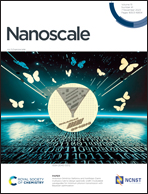Highly electron-deficient ultrathin Co nanosheets supported on mesoporous Cr2O3 for catalytic hydrogen evolution from ammonia borane†
Abstract
The hydrolysis of ammonia borane (NH3BH3) on metal-based heterogeneous catalysts under light irradiation has been considered as an efficient technique for hydrogen (H2) generation, in which the activity of the catalyst can be improved by increasing the electron density of the active metal. However, studies focused on reducing the electron density of the active metal are rare. Here, we report an electron density manipulation strategy to prepare highly electron-deficient ultrathin Co nanosheets via transferring nanosheets to support mesoporous Cr2O3 by simple one-step in situ reduction (denoted as Co/Cr2O3). X-ray photoelectron spectroscopy (XPS) and X-ray absorption near-edge structure (XANES) spectra confirm the formation of electron-deficient Co nanosheets and the Co–O–Cr bond due to electron transfer from the nanosheets to mesoporous Cr2O3. Importantly, the Co–O–Cr bond can work as a bridge to accelerate the electron transfer under light irradiation and then improve the electron-deficiency degree of Co nanosheets. As a result, the optimal Co/Cr2O3 exhibits a high intrinsic catalytic performance with the turnover frequency (TOF) value of 106.8 min−1 and significantly reduces the activation energy (Ea) to 16.8 kJ mol−1 under visible light irradiation, which make it among the best ever recorded monometallic Co-based catalyst with enriched electrons. The density functional theory (DFT) calculation results suggest that the electron-deficient Co nanosheets are responsible for the greatly decreased H2O activation and dissociation energy barriers and then the acceleration of the evolution of H2. The work provides a new perspective for designing high efficiency catalysts for H2 production, which is beneficial for relative energy conversion and storage catalysis.



 Please wait while we load your content...
Please wait while we load your content...